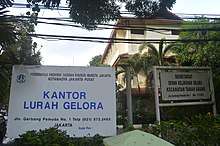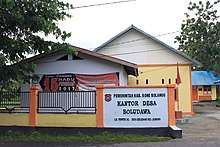Villages of Indonesia
In Indonesia, village or subdistrict is the fourth-level subdivision below a district, regency/city, and province. There are a number of names and types for villages in Indonesia, with desa (rural village) being the most frequently used for regencies and kelurahan (urban village) for cities. According to the 2019 report by the Ministry of Home Affairs, there are 8,488 urban villages and 74,953 rural villages in Indonesia.[1]
| This article is part of a series on |
| Subdivisions of Indonesia |
|---|
| Level 1 |
|
| Level 2 |
| (Full list; GDP; population) |
| Level 3 |
|
| Level 4 |
|
Types of villages
Kelurahan

Kelurahan is an urban village terminology used in cities as well as a few part of regencies.[2][3] It is commonly translated to English as subdistrict. The leader of kelurahan is called lurah. A lurah is a civil servant appointed by the district head. According to the Regulation of the Minister of Home Affairs Number 31 of 2006, a kelurahan can be created with the following criteria:
- Java and Bali: having at least 4,500 residents or 900 families within an area of at least 3 km².
- Sumatra and Sulawesi: having at least 2,000 residents or 400 families within an area of at least 5 km².
- Kalimantan, West Nusa Tenggara, East Nusa Tenggara, Maluku, and Papua: having at least 900 residents or 180 families within an area of at least 7 km².
A kelurahan must have a government office, an established transportation network, adequate communication facilities, and public facilities. If it no longer meets the above conditions it can be abolished or combined with other kelurahans based on the results of research and studies conducted by the city/regency government.[4]
Desa

Desa is a rural village terminology used in majority of regencies in Indonesia.[3] However, several provinces have adopted their own terminology for their traditional villages (desa adat). The leader of a desa does not have a civil servant status and is chosen by the public through an election. According to the Law Number 6 of 2014, desa and desa adat are legal community units that have territorial boundaries that are authorized to regulate and administer government affairs, community interests based on community initiatives, original rights, and/or traditional rights recognized and respected in the government system of the Republic of Indonesia.[5]
Variations of desa terminology in Indonesia include:
- Gampong in Aceh[6]
- Nagari in West Sumatra[7]
- Dusun in Bungo Regency (Jambi)[8]
- Kampung in some places in Indonesia:[9]
- Lampung (in Central Lampung, Mesuji, Tulang Bawang, Way Kanan, and West Tulangbawang regencies)
- East Kalimantan (in Berau and West Kutai regencies)
- Papua
- West Papua
- Pekon in Pringsewu, Tanggamus, and West Lampung regencies (Lampung)
- In Bali, there are two forms of desa, i.e. desa dinas (service village) and desa adat (cultural village). Desa dinas deals with administrative functions, while desa adat deals with religious and cultural functions.[10]
- Lembang in Toraja and North Toraja regencies (South Sulawesi)[11]
- Kalurahan in Special Region of Yogyakarta.[12]
Number of villages
| Provinces | Number of villages as of 2019[1] | ||
|---|---|---|---|
| Kelurahan | Desa | Total | |
| Aceh | 0 | 6,497 | 6,497 |
| North Sumatra | 693 | 5,417 | 6,110 |
| West Sumatra | 230 | 928 | 1,158 |
| Riau | 268 | 1,591 | 1,859 |
| Jambi | 163 | 1,399 | 1,562 |
| South Sumatra | 387 | 2,853 | 3,240 |
| Bengkulu | 172 | 1,341 | 1,513 |
| Lampung | 205 | 2,435 | 2,640 |
| Bangka Belitung Islands | 82 | 309 | 391 |
| Riau Islands | 142 | 275 | 417 |
| Special Capital Region of Jakarta | 267 | 0 | 267 |
| West Java | 645 | 5,312 | 5,957 |
| Central Java | 753 | 7,809 | 8,562 |
| Special Region of Yogyakarta | 46 | 392 | 438 |
| East Java | 777 | 7,724 | 8,501 |
| Banten | 313 | 1,238 | 1,551 |
| Bali | 80 | 636 | 716 |
| West Nusa Tenggara | 142 | 995 | 1,137 |
| East Nusa Tenggara | 327 | 3,026 | 3,353 |
| West Kalimantan | 99 | 2,031 | 2,130 |
| Central Kalimantan | 139 | 1,432 | 1,571 |
| South Kalimantan | 144 | 1,864 | 2,008 |
| East Kalimantan | 197 | 841 | 1,038 |
| North Kalimantan | 35 | 447 | 482 |
| North Sulawesi | 332 | 1,507 | 1,839 |
| Central Sulawesi | 175 | 1,842 | 2,017 |
| South Sulawesi | 792 | 2,255 | 3,047 |
| Southeast Sulawesi | 377 | 1,911 | 2,288 |
| Gorontalo | 72 | 657 | 729 |
| West Sulawesi | 73 | 575 | 648 |
| Maluku | 35 | 1,198 | 1,233 |
| North Maluku | 118 | 1,063 | 1,181 |
| West Papua | 95 | 1,742 | 1,837 |
| Papua | 110 | 5,411 | 5,521 |
| Total | 8,488 | 74,953 | 83,441 |
References
- "Peraturan Menteri Dalam Negeri Nomor 72 Tahun 2019 tentang Perubahan atas Permendagri nomor 137 Tahun 2017 tentang Kode dan Data Wilayah Administrasi Pemerintahan" (PDF). Ministry of Home Affairs. Retrieved 15 January 2020.
- "Nama Kecamatan, Ibukota dan Jumlah Desa/Kelurahan di Kota Jambi, 2015". Statistics Indonesia. Retrieved 22 January 2020.
- "Nama Kecamatan, Ibukota dan Jumlah Desa/Kelurahan di Kabupaten Muaro Jambi, 2015". Statistics Indonesia. Retrieved 22 January 2020.
- "Peraturan Menteri Dalam Negeri Nomor 31 Tahun 2006". Hukum Online. Retrieved 22 January 2020.
- "Undang-Undang Republik Indonesia Nomor 6 Tahun 2014 Tentang Desa" (PDF). People's Representative Council. Retrieved 22 January 2020.
- "Qanun Provinsi Aceh Nomor 5 Tahun 2003 Tentang Pemerintahan Gampong" (PDF). Government of Aceh. Retrieved 22 January 2020.
- "Peraturan Daerah Provinsi Sumatera Barat Nomor 7 Tahun 2018 Tentang Nagari" (PDF). Audit Board of Indonesia. Retrieved 22 January 2020.
- In other places, "dusun" is an administrative division form below "desa".
- In other places, "kampung" is equal with "dusun", except in Bungo, Jambi.
- "Mendagri Setujui Perda Desa Adat". Bali Post. 19 September 2019. Retrieved 22 January 2020.
- "Peraturan Daerah Kabupaten Toraja Utara Nomor 3 Tahun 2014 Tentang Pemerintahan Lembang" (PDF). Audit Board of Indonesia. Retrieved 22 January 2020.
- "Peraturan Gubernur Nomor 25 Tahun 2019". Government of the Special Region of Yogyakarta. Retrieved 22 January 2020.